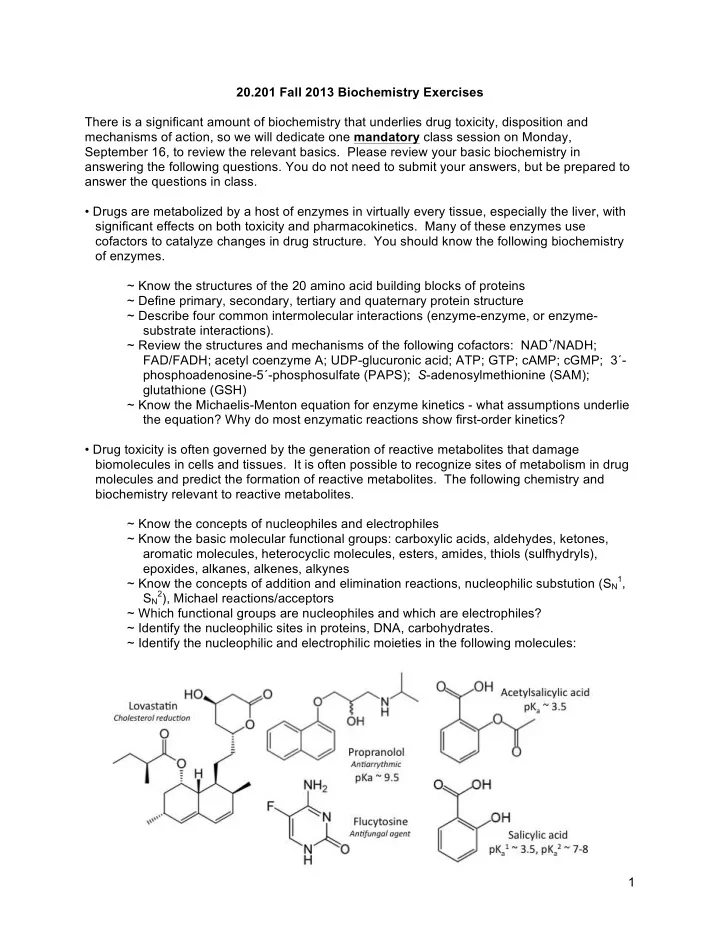

20.201 Fall 2013 Biochemistry Exercises There is a significant amount of biochemistry that underlies drug toxicity, disposition and mechanisms of action, so we will dedicate one mandatory class session on Monday, September 16, to review the relevant basics. Please review your basic biochemistry in answering the following questions. You do not need to submit your answers, but be prepared to answer the questions in class. • Drugs are metabolized by a host of enzymes in virtually every tissue, especially the liver, with significant effects on both toxicity and pharmacokinetics. Many of these enzymes use cofactors to catalyze changes in drug structure. You should know the following biochemistry of enzymes. ~ Know the structures of the 20 amino acid building blocks of proteins ~ Define primary, secondary, tertiary and quaternary protein structure ~ Describe four common intermolecular interactions (enzyme-enzyme, or enzyme- substrate interactions). ~ Review the structures and mechanisms of the following cofactors: NAD + /NADH; FAD/FADH; acetyl coenzyme A; UDP-glucuronic acid; ATP; GTP; cAMP; cGMP; 3´- phosphoadenosine-5´-phosphosulfate (PAPS); S -adenosylmethionine (SAM); glutathione (GSH) ~ Know the Michaelis-Menton equation for enzyme kinetics - what assumptions underlie the equation? Why do most enzymatic reactions show first-order kinetics? • Drug toxicity is often governed by the generation of reactive metabolites that damage biomolecules in cells and tissues. It is often possible to recognize sites of metabolism in drug molecules and predict the formation of reactive metabolites. The following chemistry and biochemistry relevant to reactive metabolites. ~ Know the concepts of nucleophiles and electrophiles ~ Know the basic molecular functional groups: carboxylic acids, aldehydes, ketones, aromatic molecules, heterocyclic molecules, esters, amides, thiols (sulfhydryls), epoxides, alkanes, alkenes, alkynes ~ Know the concepts of addition and elimination reactions, nucleophilic substution (S 1 N , S 2 N ), Michael reactions/acceptors ~ Which functional groups are nucleophiles and which are electrophiles? ~ Identify the nucleophilic sites in proteins, DNA, carbohydrates. ~ Identify the nucleophilic and electrophilic moieties in the following molecules: 1
• Drugs are often acids and bases, so local pH can affect all aspects of drug uptake, distribution, metabolism, elimination and toxicity. Know the following concepts of acid-base chemistry. ~ Derive the Henderson-Hasselbalch equation ~ Know the ballpark pK a values for common functional groups ~ Define the acidic and basic side chains of amino acids ~ What is the net charge on glutathione at pH 7.4? ~ What is the charge of propranolol in blood at pH 7.4? ~ How do acid-base properties relate to nucleophilicity? • Metabolic reactions often involve oxidation and reduction chemistry. Know the following concepts. ~ What is the charge of a molecule after the removal of an electron? ~ What is the charge on a molecule after homolytic bond scission (e.g., hydrogen atom abstraction)? ~ Define the term reduction and give an example of a reduction reaction. ~ Glutathione is an important cellular nucleophile and maintains the redox potential in cells. Describe how it is involved in both processes. ~ Oxidize an alkane to: an alcohol, an aldehyde, a ketone, a carboxylic acid. • Kinetic concepts are pervasive in drug development, mechanisms of action, toxicity and, obviously, pharmacokinetics. Know the following features of chemical and biological kinetics. ~ Derive the rate equations for zero-, first- and second-order reaction kinetics. ~ Derive the equation for the half-life of a first-order reaction and define the term. ~ How do these concepts of chemical kinetics relate to the concepts of exponential growth and decay? • Thermodynamic concepts are also pervasive in the mechanisms of action of drugs. Know the following features of thermodynamics relevant to pharmacology. ~ Derive the equation for an equilibrium association constant. ~ What is the difference between an acid dissociation constant and an equilibrium association constant? ~ What are the units for association and dissociation constants? ~ Define the octanol water partitioning coefficient (C log P). ~ Describe how functional groups on drug-like molecules affect solubility. ~ How do charged molecules cross lipid bilayers? 2
� � � � � � � � � � � � � � �� � � � � � � � � � � � � � � � � � � � � � � � � � � � � � � � � � � � � � � � � � � � � � � � � � � � � � � � � � � � � � � � � � � � � � � � � � � � � � � � � � � � � � � � � � � � � � � � � � � � � � � � � � � � � � � � � � � � � � � � � � � � � � � � � � � � � � � � � � � � � � � � � � � � � � � � � � � � � � � � � � � �
Recommend
More recommend